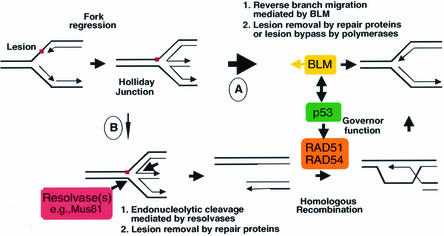Fig. 7. Mechanistic model for the restoration of stalled DNA replication forks. A regressed replication fork is restored by either reverse branch migration mediated by BLM helicase in a non-recombinogenic pathway (indicated by a thick arrow, pathway A) or a recombinogenic pathway that involves endonucleolytic cleavage by a resolvase(s) (e.g. Mus81), followed by RAD51/RAD54-mediated HR (indicated by a thin arrow, pathway B). p53 functions as a ‘molecular governor’ of HR. The simplified model shows a single DNA lesion at a replication fork that could represent a carcinogen–DNA adduct, a UV photoproduct or a base damaged by a free radical.

An official website of the United States government
Here's how you know
Official websites use .gov
A
.gov website belongs to an official
government organization in the United States.
Secure .gov websites use HTTPS
A lock (
) or https:// means you've safely
connected to the .gov website. Share sensitive
information only on official, secure websites.
